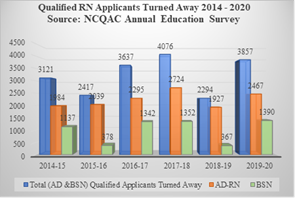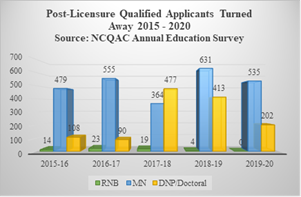
Qualified applicants are being denied admission to nursing schools due to diminished program capacity nationally and within Washington state. In 2019, 80,407 qualified applicants were denied access to both baccalaureate and graduate programs nationally.1 In Washington state, 19,402 applicants were denied access to associate and baccalaureate degree programs, leading to an overall 50% acceptance rate from 2014-2020.2 Associate and baccalaureate degree programs both admitted approximately 1,500 students in Washington state from 2019-2020, indicating similar capacity challenges across these pre-licensure programs.2 Qualified applicants were also turned away from post-licensure programs, such as Advanced Practice Registered Nurse (ARNP) and Doctor of Nursing Practice (DNP) programs, which diminishes the number of potential providers to care for those in rural communities and those with complex care needs, and potential nursing educators.3


Note: Data limitation does not account for duplicate
applicants, potentially inflating applicant numbers. 2
While the nursing workforce is expected to grow within the United States to a total of 3.3 million nurses nationally, current projections also simultaneously indicate that national nursing shortages will continue through 2030, adding further complexity to this issue.3 At present, 194,500 vacancies exist within the nursing workforce annually and one million nurses are expected to retire by 2030.3,4 The creation of an active pipeline of future nurses is critical to care for our aging population, and barriers must be identified that prevent the flow of nurses into frontline, leadership, provider, and faculty roles.
One major challenge that impacts nursing program capacity is a lack of a sufficient number of clinical placements, which are opportunities for students to apply classroom concepts in direct patient care settings. The other major challenge is insufficient nurse faculty to educate students. Nationally, the west coast leads in vacancies of nurse faculty.5 Strategies to address nurse faculty retention include mentoring opportunities for those interested in faculty roles, federal loan repayment programs, and increased financial incentives to choose nursing education as a career. To implement these strategies, collaboration with healthcare and community stakeholders is needed, along with legislative action to advocate for increased resources to change the future of nursing education within Washington and the United States.
Policy Analysis
Washington State Legislature House Bill 2158: HB 2158 was passed in 2019, which invested $40 million in salaries for nurse educators working in community or technical college settings and reflected an overall 26.5% increase in salaries for these nurse faculty members. While this legislation was crucial in providing salary increases to community and technical college faculty, it did not impact the salary for nurse faculty teaching in 4-year college settings.6,7,8 The impact of this legislation was to support community and technical colleges in recruiting much needed faculty. However, an inequity in the ability of four-year colleges and universities to recruit nurse faculty has widened. Most BSN degree programs are in four-year colleges and universities. BSN programs admit approximately half of the total number of RN students each year2.
Washington State Legislature House Bill 2007: Demand data by the Washington Center for Nursing shows that the average wage for nurse faculty in 2020 was $88,738, compared to registered nursing at $88,018. This demonstrates that there is little financial incentive by income for registered nurses to choose a nurse faculty role. The vast majority of nurse faculty in Washington have a master’s degree in nursing, while registered nurses can have an associates or bachelor’s degree in nursing. Nurse faculty are also required to maintain an advanced degree, with graduate student loans often totaling around $100,000 and median faculty salaries ranging between $67,000-$93,000. Passed in March 2022, HB 2007 establishes a nurse educator loan repayment (NELR) program, which reimburses up to $75,000 for 3 years of full-time faculty employment. While this bill does provide financial incentive to pursue a career in nursing education, it does not fully cover a nurse faculty’s loans based on their median salary and potential loan accrual.2,6,9,10
2021-2023 Supplemental Budget Report: The 2021-2023 Washington state supplemental budget shows increased governmental commitment to nursing education. $3 million is allotted to implement HB 2007. The supplemental budget also funds additional student admissions to nursing programs and new nursing programs in Washington state.11,12
Congressional House Resolution 851: HR 851 focuses on expanding the capacity and infrastructure of nursing schools within the United States. It invests $1 billion in nursing schools, helping them to meet current and future health challenges by addressing faculty and student recruitment and retention, further developing educational programs, and expanding clinical partnerships within healthcare facilities. While HR 851 was introduced to Congress in February 2021, no movement has occurred on the bill, indicating there is opportunity for nursing advocacy to bring further attention to this legislation. 13,14
Recommendations
The supplemental budget indicates that nursing education is a high priority in Washington state. The creation of additional student admissions to nursing programs underscores the need for the recruitment and retention of nursing faculty. HB 2158 was instrumental in increasing pay for community and technical college faculty. Expanding this legislation to improve pay for nurse faculty in 4-year colleges could help to recruit and retain nurse faculty in these settings more equitably. While HB 2007 does offer substantial financial reimbursement through the NELR program, further repayment options and salary increases are needed to increase nurse faculty employment. Congressional movement on HR 851 is also recommended, as it would aid in revitalizing nursing education nationally through the resolution’s $1 billion investment in nursing education.
Contact Information
Sofia Aragon, JD, BSN, RN, Executive Director, Washington Center for Nursing
Email: sofiaa@wcnursing.org O: 206.787.1200 x107
WCN student preparing the report: Sarah Lewicki BSN, RN, CPN, CCRN
Email: sarah.lewicki@gmail.com
Date brief created: 5/28/22
Title: A Break in the Workforce Pipeline: Nursing Program Capacity Challenges
References
1 American Association of Colleges of Nursing. (2020, September). Nursing shortage factsheet. https://www.aacnnursing.org/Portals/42/News/Factsheets/Nursing-Shortage-Factsheet.pdf
2 Flores-Montoya, A. & Moulton Burwell, P. (2022). Washington state nursing education trend report academic years 2014-2020. Washington Center for Nursing. https://www.wcnursing.org/wp-content/uploads/documents/reports/2022.4_WCN-WA-State-Nursing-Education-Report-Academic-Years-2014-2020_FINAL.pdf
3 Buerhaus, P., Skinner, L. E., Auerbach, D. I., & Staiger, D. O. (2017). Four challenges facing the nursing workforce in the United States. Journal of Nursing Regulation, 8(2), 40–46. https://doi.org/10.1016/S2155-8256(17)30097-2
4 U.S Bureau of Labor Statistics. (2021, September 8). Occupational outlook handbook. https://www.bls.gov/ooh/healthcare/registered-nurses.htm#
5 American Association of Colleges of Nursing. (2021, August 17). Data spotlight: Insights on the nursing faculty shortage. https://www.aacnnursing.org/News-Information/News/View/ArticleId/25043/data-spotlight-august-2021-Nursing-Faculty-Shortage
6 Nursing Care Quality Assurance Commission. (2020, May). Nursing education programs annual report: 2018-2019 statistical summary and trends. https://doh.wa.gov/newsroom/nursing-education-programs-annual-school-report
7 Washington Center for Nursing. (2019, June 19). Action Now! News release: Legislature’s $40 million investment in nurse educator salaries major step forward in Action Now! plan. https://www.wcnursing.org/action-now-news-release/
8 Washington State Legislature. (2019). Final bill report E2SHB 2158. https://lawfilesext.leg.wa.gov/biennium/2019-20/Pdf/Bill%20Reports/House/2158-S2.E%20HBR%20FBR%2019.pdf?q=20220528120731
9 Washington State Legislature. (n.d.). Bill information: HB 2007. Retrieved on May 28th, 2022, from https://app.leg.wa.gov/billsummary?BillNumber=2007&Year=2021&Initiative=false
10 National Advisory Council on Nurse Education and Practice. (2020, December). Preparing nurse faculty, and addressing the shortage of nurse faculty and clinical preceptors. https://www.hrsa.gov/sites/default/files/hrsa/advisory-committees/nursing/reports/nacnep-17report-2021.pdf
11 Washington State Nurses Association. (2022). End of session report. https://www.wsna.org/legislative-affairs/2022/end-of-session-report
12Washington State Hospital Association. (2022). Legislature releases final supplemental budget. https://www.wsha.org/articles/legislature-releases-final-supplemental-budget/
13 American Association of Colleges of Nursing. (2021, February 10). AACN’s Washington weekly. https://www.aacnnursing.org/Policy-Advocacy/View/ArticleId/24777/washington-weekly-2-10-21
14 Congress.Gov. (n.d.). H.R. 851- FAAN act. Retrieved on May 28th, 2022 from https://www.congress.gov/bill/117th-congress/house-bill/851/text?r=1&s=

